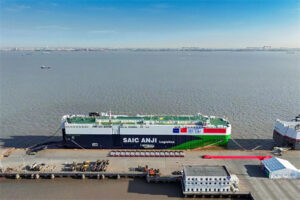YEARS of supply-chain woes and maritime challenges put container and energy shipping in the headlines. Now, car carriers are set to steal the spotlight as the global structure of auto trade swings toward China and electric vehicles. Massive boat-buying deals may not be financially savvy but could offer a strategic advantage as carmakers hunt new markets.
Predictions for strong overseas sales growth by BYD Co. and SAIC Motor Corp. spurred both Chinese automakers to put in orders for a category of ocean-going ships called roll-on, roll-off. BYD, which is neck-and-neck with Tesla, Inc. as the world’s largest EV maker last week commenced the maiden voyage of its BYD Explorer No. 1 en route to Europe with 5,000 cars. The Shenzhen-based company is working with China International Marine Containers Group Co. to build boats and plans to add seven more to its fleet in the next two years, it said.
SAIC, whose brands include MG, has put in an order for at least 12 new ships, including one built by China State Shipbuilding Corp. capable of carrying 7,600 cars. That vessel, SAIC Anji Sincerity, set off this month for Europe and is reported to be the world’s largest dual-fuel carrier, capable of running on LNG or diesel.
Most of these deals were lined up in 2022, when capacity for ocean transport was tight and Chinese EV makers were confident the boom would continue. All up, $8.1 billion worth of these ships were contracted for construction by the end of 2022. Notably, 93% of those were for dual-fuel LNG vessels, and more than 80% were to be built in China, according to Clarksons Research.
From a strategic point of view, buying car-carriers makes sense for Chinese automakers. From a financial perspective, it may not.
Take SAIC. The company sold 5 million vehicles in 2023, 1.12 million of which were new-energy models. NEV is a catch-all term that comprises anything that’s not solely a combustion-engine car, which might include pure battery EVs, hybrids, and plug-in hybrids. Significantly, overseas sales growth outstripped domestic, climbing 19% to account for almost a quarter of all units sold last year.
BYD, by contrast, sold 3.02 million NEVs. But only 242,765 of those, just over 8%, went abroad. According to Caixin, the eight ships it has on order will total 5 billion yuan ($695 million). That’s a drop in the ocean compared to the 611 billion yuan in revenue the automaker is estimated to have brought in last year. But it’s not nothing, and spaced out over a few years, could drag on margins.
Yet BYD didn’t actually buy the vessels directly. Instead, BYD Explorer No. 1 is owned by Zodiac Maritime, which will manage the ship on the carmaker’s behalf. A common business model in marine transport is for a client to sign up for a long-term lease, and let an expert buy and run the vessel. Norway’s Hoegh Autoliners recently announced a similar deal — it will operate car transport for an unnamed East Asian client over the next five years.
Whether you’re shipping at SAIC’s scale or at a more-modest BYD level, what you’re really doing with such deals is betting on two things: that there will be enough foreign orders in coming years to justify a long-term shipping contract, and transport rates in the spot market will consistently be higher than what was negotiated in a multi-year deal.
A look at the recent car-shipping industry indicates a locked-in strategy was the right move at the time. When BYD and SAIC were in the market for sea transport, capacity was tight.
“There weren’t enough boats, there weren’t enough trains, there weren’t enough car carriers,” Tesla Chief Executive Officer Elon Musk complained in October 2022, when the US carmaker’s deliveries fell short of expectations. In that context, writing fat checks made sense for a major Chinese auto manufacturer with bold overseas ambitions. Even now, it appears smart. In mid-December, car carriers were being chartered for a record $115,000 per day — seven times the average rate seen in 2019.
The delivery of new ships is coming fast. There are currently around 760 car carriers in operation globally with total capacity of 4 million car-equivalent units (the vehicle version of TEU). But 80 newbuild orders were signed last year, according to Clarksons Research, with total capacity equal to 37% of the current fleet. That could mean excess capacity in a couple of years and a sharp drop in spot rates, similar to what experienced with container shipping.
On balance, companies like BYD and SAIC seem more concerned with whether they can actually get their cars to market than the cost of doing so. When you’re a fast-growing company intent on breaking into new territories, long-term strategy may trump short-term financial returns. Should foreign markets like Europe, the US and the Middle East really take to Chinese EVs, then these ship deals will seem savvy. If not, they could hang like an albatross around carmakers’ necks.
BLOOMBERG OPINION
